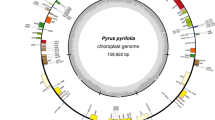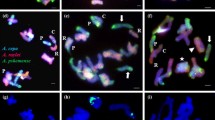Abstract
Genomic DNA of Paulownia fortunei, P. kawakamii and P. taiwaniana were amplified with 10-base primers of arbitrary sequences using the polymerase chain reaction (PCR). A total of 351 DNA fragments were amplified from 23 primers and of these 265 fragments (75.5%) were polymorphic. Almost all of the PCR-amplified products of P. taiwaniana were shared by either P. fortunei or P. kawakamii, or both, and the number of polymorphic fragments shared by P. taiwaniana and P. fortunei was about equivalent to those shared by P. taiwaniana and P. kawakamii. Restriction fragments of chloroplast DNA (cpDNA) purified from Paulownia species and from reciprocal crosses between P. fortunei and P. kawakamii were analyzed. Restriction enzyme SalI-digested cpDNA showed an identical pattern in both P. kawakamii and P. taiwaniana. These results further support the hypothesis that P. taiwaniana is the natural hybrid between P. fortunei and P. kawakamii and that the maternal parent of P. taiwaniana is P. kawakamii.
Similar content being viewed by others
References
Baum BR, Bailey LG (1989) Species relationships in the Hordeum murinum aggregate viewed from chloroplast DNA restriction fragment patterns. Theor Appl Genet 78:311–317
Bremer B, Jansen RK (1991) Comparative restriction site mapping of chloroplast DNA implies new phylogenetic relationships within Rubiaceae. Am J Bot 78:198–213
Carlson JE, Tulsieram LK, Glaubitz JC, Luk VWK, Kauffeldt C, Rutledge R (1991) Segregation of random amplified DNA markers in F1 progeny of conifers. Theor Appl Genet 83:194–200
Chen ZY (1986) Suggestion on the classification of the genus Paulownia. J Huazhong Agric Univ 5:261–265
Finkeldey R (1992) The hybrid origin of Paulownia Taiwaniana Hu and Chang — evidence from isozyme gene markers. Silvae Genet 41:278–282
Gillham NW (1978) Organelle heredity. Raven Press, New York
Hu TW, Chang HT (1975) A new species of Paulownia from Taiwan — P. taiwaniana Hu et Chang. Taiwania 20:165–171
Hu TW, Lin TP (1975) The trichomes of Paulownia of Taiwan. Q J Chinese For 8:1–9
Lin TP, Wang YS (1991) Paulownia taiwaniana, a hybrid between P. fortunei and P. kawakamii (Scrophulariaceae). Plant Syst Evol 178:259–269
Neale DB, Sederoff RR (1989) Paternal inheritance of chloroplast DNA and maternal inheritance of mitochondrial DNA in loblolly pine. Theor Appl Genet 77:212–216
Nei M, Li WH (1979) Mathematical model for study genetic variation in terms of restriction endonucleases. Proc Natl Acad Sci USA 74:5267–5273
Philbrick CT, Jansen RK (1991) Phylogenetic studies of North American Callitriche (Callitrichaceae) using chloroplast DNA restriction fragment analysis. Syst Bot 16:478–491
Rafalski JA, Tingey SV, Williams JGK (1991) RAPD markers — a new technology for genetic mapping and plant breeding. Agric Biotechnol News Inf 3:645–648
Riedy MF, Hamilton III WJ, Aquadro CF (1992) Excess of nonparental bands in offspring from known primate pedigrees assayed using RAPD PCR. Nucleic Acids Res 20:918
Rin UC (1979) Silvicultural studies on Taiwan Paulownia (Paulownia taiwaniana Hu et Chang) in Taiwan. Research Bulletin No. 178, Department of Forestry, National Chung-Hsing University
Sambrook J, Fritsch EF, Maniatis T (1989) Molecular cloning — a laboratory manual, 2nd edn. Cold Spring Harbor Laboratory Press, Cold Spring Harbor, N.Y.
Schuler MA, Zielinski RE (1989) Methods in plant molecular biology. Academic Press, New York
Stine M, Sears BB, Keathley DE (1989) Inheritance of plastids in interspecific hybrids of blue spruce and white spruce. Theor Appl Genet 78:768–774
Williams JGK, Kubelik AR, Livak KJ, Rafalski JA, Tingey SV (1990) DNA polymorphisms amplified by arbitrary primers are useful as genetic markers. Nucleic Acids Res 18:6531–6535
Xiong JQ, Chen ZY (1992) A study on numerical taxonomy of the genus Paulownia. Bull Bot Res 12:185–188
Author information
Authors and Affiliations
Additional information
Communicated by P. M. A. Tigerstedt
This work was supported in part by the National Science Council (NSC-80-0409-B-054-06), Republic of China
Rights and permissions
About this article
Cite this article
Wang, W.Y., Pai, R.C., Lai, C.C. et al. Molecular evidence for the hybrid origin of Paulownia Taiwaniana based on RAPD markers and RFLP of chloroplast DNA. Theoret. Appl. Genetics 89, 271–275 (1994). https://doi.org/10.1007/BF00225153
Received:
Accepted:
Issue Date:
DOI: https://doi.org/10.1007/BF00225153




